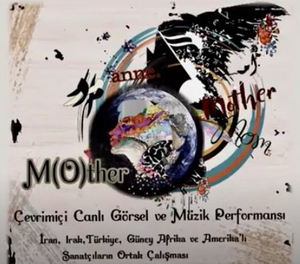Review: M(O)THER at Boston Experimental Theatre
Read our review for this virtual production.

With director Vahdat Yeganeh and a team of artists streaming in live from around the globe, Boston Experimental Theatre has perfectly divined that elusive piece of performance art that neither begrudgingly embraces its virtual form nor coyly alludes to its obvious limits, but rather exists in a way that could never wholly be replicated in another medium. I realized recently while watching Poor Connection, a collaboration between three Iranian-American theatre artists, how refreshing it is to see people actually do things in virtual theatre. The three actors in the piece applied makeup, folded laundry, and cleared dishes in the kitchen. By writing a work that took place in individual living spaces rather than on Caliban's enchanted isle or Madame Ranevskaya's cherry farm, the trio was able to engage with 'props' authentically. After months of watching eyes scan PDFs of scripts and conceding that a few well-placed fingers are guns or a white slip is a wedding gown, genuine action and genuine purpose felt refreshing.
Boston Experimental Theatre's M(o)ther takes this human fascination of watching others perform concrete, tangible tasks to the next level. The team of artists from Iran, Iraq, Turkey, South Africa, and the United States escapes the limitations of restrictive labels often imposed in Western theatre. A painter stands in front of a white wall smeared with cascading paint and dances in the gently shifting beam of a single flashlight before turning to paint on the wall. Chimes resonate and the sound of an empty spray paint can persists underscoring the recitation of a poem by a musician whose computer screen has illuminated only an animated hand and the structural geometry of a violin. A panting aerial dancer lowers from the swirling silks under a massive tree to relay a manic verse.
The primary success of M(o)ther is, first and foremost, that it gives its audience very few windows into the artists' personal environments. Though filmed simultaneously around the world, each performer exists in a nondescript landscape of shadows. The few that give us glimpses of their corporeal spatial boundaries heighten the dreamlike (often nightmarish) liminal space the piece occupies. A tree in a field under a cloudless expanse of sky, a void-like ectoplasm of dark paint behind a pianist that pulsates in the glow of an inferno, a room filled with hanging chimes. As the poetic text alludes to dreams, one is transported to a shifting, contorting world of unrelated images juxtaposed against each other just as in a dream. Violins, sitars, tambourines, chimes, and pianos randomly overlap with each other, disregarding pacing, pitch, and genre of the others in a tense cacophony. A particularly strong image is evoked as one performer reveals marker drawings suggesting people on her arms. She begins twisting and waving her arms as another performer joins the screen gyrating and swinging from silks. Suddenly, there is a sense of immense freedom from one side of the screen while the other side feels to suggest a trapped state- the torture of forever existing as the tattoos on a puppeteer's forearms.
One sequence features two actors in a tense dialogue that spirals in tortuous curly-cues around repeated questions.
"What is my dream?
What is my home?
My dream is difficult.
My home is divided.
My flesh is hardened."
The international yet placeless scope of the performance posits this multi-lingual interaction in a complicated context. Can they not understand each other because they are speaking different languages? Is the Zoom reception fuzzy? Is the soundscape drowning them out? Perhaps a combination of all of these challenges, the effect situates the two characters in different realms, although visually they are each encompassed in uniform shadows. Divisions of heaven and hell or living and dead seem just beneath the surface.
Though the performance is a worthwhile watch and certainly pushes the form of virtual theatre, it is essentially a series of a few striking visuals and accompanying sounds lost in a sea of nebulous ephemera. I argue that, within a half-hour confine, the piece could have featured its most effective moments and delivered a more impactful product. The frenzied, declamatory style used to deliver most of the poetry becomes monotonous and leaves the verses, as well as the performers, as blandly interchangeable. I argue that, sans text, this performance would feel more polished and suggestive, or conversely, if the performers serviced the intentions of the language more authentically (as opposed to coopting language and sliding it in as the bearer of a specific style) they might have maintained the individuality of M(o)ther's design.
Check out the archival footage here.
Reader Reviews
Videos

